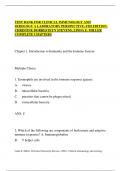Exam (elaborations)
Clinical Immunology and Serology: A Laboratory Perspective 4th Edition Test Bank...
Clinical Immunology and Serology: A Laboratory Perspective 4th Edition Test Bank Clinical Immunology and Serology: A Laboratory Perspective 4th Edition Test Bank
[Show more]



